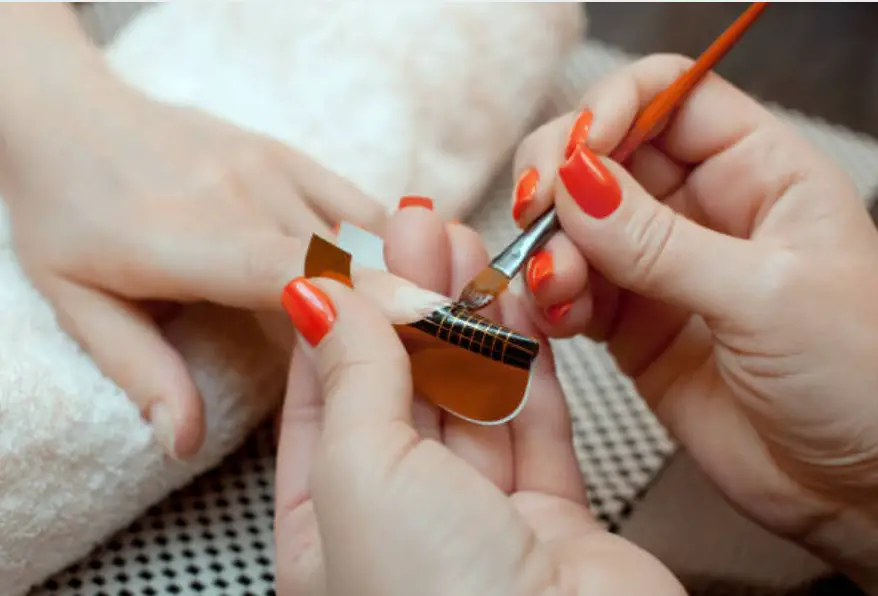Acrylic nails are invincible but to make them durable you certainly need to follow essentials steps. Does one such step include a base coat for acrylic nails? Well, it is not only about whether you need a base coat for acrylic nails, but also what a base coat does to your nails. Let me clarify below.

A Mighty Base Coat & its Function
A base coat is a transparent polish used before applying nail paint or gel color. Base coats extend the life of ordinary nail paint, gel manicures, and prevent fingernail fading. A base coat also creates a smooth nail foundation for nail polish adherence.
Plasticizers in base coatings make them flexible, while cellulose helps them adhere better. These plasticizers enable the nail paint you put to the nail to flex rather than break, extending the life of your manicure. Base coats protect the natural nail from the chemicals in nail varnish by forming a barrier between it and the chemicals in the polish and gel.
Some base coats include vitamins, proteins, and calcium, which are beneficial to the nails. Apply a base coat on the nail plate after buffing the fingernails during a manicure, then apply the nail paint or gel.
Do you need a base coat for acrylic?
Acrylic nails do not require the use of a base coat. Acrylic nails require a primer before they can be applied. Base Coats and Nail Primers are all used to extend the life of your manicures. However, they work in various ways and with different things. Nail primers help prepare the base of your fingernails to help acrylic or nail lacquer adhere to your fingernail plates better.
Do You Need A Gel Base Coat For Acrylic Nails?
Gel Base Coats are used with gel and regular polishes, not acrylics. It’s best to use nail primers while installing artificial nails. Using a mixture of Isopropyl alcohol and Acetone to produce a DIY Nail Primer is the simplest method. Acetone and Isopropyl Alcohol, when applied appropriately, may eliminate the majority of the oil and humidity from your nails, allowing your acrylics to remain longer without lifting.
Primers are formed up of molecules with two ends – hydrophobic and hydrophilic – whether they contain acidic elements (acid primer) or not (acid-free primer). The former indicates that the molecule is repelling water, whereas the latter indicates that it is attracted to it.
MAA is present in acid-based primers, often known as Original Primers (Methacrylic Acid). The acid-free ones aren’t entirely acid-free. At the very least, they contain residues of a gentler acid. A base coat will contain various chemicals such as solvents, plasticizers, and other substances such as protein, Vitamin E, and calcium, among other things. These work together to nourish your nails and increase their health. The nail primer’s adhesive capabilities are due to the numerous chemicals it contains.
Conclusion
When opposed to a regular base coat, nail primers perform a far better job of ensuring that your acrylics stick to your nails. However, while using conventional nail paints or gels, experts advise against using nail primers unless your fingernails are susceptible to chipping, of course.
So, when is it OK to utilize primers? Using primers before applying acrylics is significantly more beneficial. For the most excellent adherence, ensure your fingernails are dehydrated. What’s the end result? Acrylics that last longer and manicures that last longer! They also extend the lifespan of the manicure, exactly like nail primers. Applying primers correctly will ensure that your acrylic nails are as beautiful as you are and that your manicure lasts as long as you need it to.
Topic: Acrylic Nails
- Is Acrylic Liquid The Same As Monomer?
- Fixed: I accidentally got my acrylic nails too long!
- Acrylic Nails Without A Drill – Why & How To?
- Beginner’s Guide To Acrylic Overlay On Natural Nails
- How long for Acrylic Nails to dry without UV light?
- Why Do Nails Grow Faster With Acrylic?
- 10 Tips For Getting Acrylic Nails For The First Time
- Acrylic Ballerina Nails Vs Coffin – Which Is Better?
- How To Get Rid Of Natural Nail Growth Under Acrylics?
- Nail Tips Vs. Acrylic – Which Is Better?
- How Long do your Nails have to be to get Acrylics?
- Can You Use Any Monomer With Your Acrylic Powder?
- How Long Does Acrylic Paint Last On Your Nails?
- Can You Mix Acrylic Powder With Gel?
- Can You Use and Mix Acrylic Paint With Nail Polish?
- Using clear nail polish to seal acrylic paint – Hot or Not?
- Are My Nails too Short for Acrylics? Overlay on Short Bitten Nails
- Does Acrylic Overlay Add Length to My Natural Nails?








